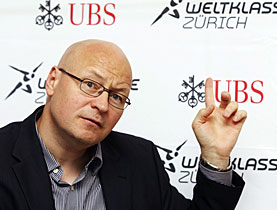Turning gold into cash

Swiss athletes have so far notched up an impressive six gold medals at the 2010 Winter Olympics. But how much does a medal boost one’s bank balance?
Despite winning two golds in Vancouver – to add to two from 2002 – ski jumper Simon Ammann is unlikely to become a millionaire.
“Not all Olympic victories are worth the same,” Giusep Fry, manager of Swiss skier Carlo Janka, who won gold in the giant slalom, told swissinfo.ch.
“It depends to a great extent on the discipline: the greater the public interest, the better the marketing possibilities.”
While four golds, in addition to being a media-friendly personality – not to mention a Harry Potter lookalike – sounds like a marketer’s dream, jumping 140 metres is turning out to be easier than attracting big international sponsors.
For a start, in Switzerland ski-jumping can’t compare with football or ice hockey – or indeed Alpine skiing.
Also, national-squad organisers Swiss Ski insists on “branch exclusivity”, meaning that if the team is sponsored by say one bank or brand of chocolate, an individual can’t be sponsored by another.
Nevertheless, Ammann’s manager Hubert Schiffmann insists things are looking good for his client.
“I wouldn’t say that a gold medal in Alpine skiing is better than a medal from Simon, because he won his fourth gold medal which is really very special. Everyone knows him in Switzerland – everyone wants to invite him and shake his hand.”
Fry adds: “Another very important factor is whether the Olympic win is a one-off – a one-medal wonder – or whether the athlete is successful over many years.”
To be franc
The International Olympic Committee likes to stress that everyone is a winner – but some certainly win a lot more than others. Indeed, the Games are a microcosm of society: a tiny minority ends up rich and in lights, while most just scrape by.
Swiss skier Didier Cuche for example can earn SFr170,000 ($158,000) in one race – three times the annual budget of Swiss skeleton champion Maya Pedersen-Bieri, who won Olympic gold in Turin in 2006 (see video). Cuche won silver in Nagano in 1998.
So how much is an Olympic gold medal worth? Metallurgically about $600 (SFr650) (see box), but judging its marketing potential isn’t easy as athletes, agents and sponsors all clam up when discussing money, citing confidentiality.
Forbes business magazine reckons that star US skier Lindsey Vonn earned $2.5 million from sponsorships last year and another $350,000 in prize money.
This put her number three on Forbes’s list of highest-earning Winter Olympians (see box), but still miles behind Roger Federer ($42 million), who was himself miles behind Tiger Woods ($137 million).
Small window
For most athletes, however, the Olympics is a small window to gain recognition and attract sponsors. One mistake and four years’ work goes down the drain.
What’s more, the Games are technically for amateurs, meaning athletes can’t wear the names of their sponsors during competition.
Winning gold however changes the equation, according to Schiffmann. “You’re an Olympic champion for your whole life.”
But while everyone might want to shake Ammann’s hand, who wants to sponsor him?
Apart from ski manufacturers and a couple of smaller partners, the only international sponsor on Ammann’s website is a well-known German sports equipment manufacturer. (True to the Olympic spirit, Janka’s website says “during the Olympics, sponsors have been taken down”.)
Since 2002 there have only been two large advertising campaigns featuring Ammann – one for a watch company and one for a dairy. Contracts like those today would net Ammann around SFr150,000, according to the Tages-Anzeiger newspaper.
Golden bonus
Schiffmann, who works for sports management company WWP, explains that “brand ambassadors” are rarely used in Switzerland: if an individual has a blip – whether professionally or personally – the brand also suffers; if a team is backed, the risk is spread. Eggs and baskets.
Take Tiger Woods, believed to be the first athlete to pocket $1 billion in earnings and endorsements. When he recently admitted to serial adultery, he promptly lost two big corporate endorsements.
Nevertheless, Schiffmann says he has received various offers since Ammann won his fourth gold, and four or five were serious enough to follow up on, adding that he’d be “satisfied” with two new big partners and “happy” with three.
As a result, prize money makes up a sizeable chunk of Ammann’s income, which last year totalled SFr334,000, according to the Tages-Anzeiger.
But bad news for top jumpers is that this season the prize structure has been changed – instead of only the top ten cashing in, now it is the top 30. Instead of SFr30,000 for a World Cup victory, winners must now make do with SFr10,000.
Ammann will at least be able to make up for this with a SFr40,000 bonus from Swiss Olympic for his two golds.
Limited brandscape
Yet another factor weighing against Ammann is the small Swiss market.
“Switzerland has around eight million people compared with 80 million in Germany,” Schiffmann said. “That’s the value of sponsorship – how many people you reach.”
Are they looking abroad? “Of course we’re looking at international markets, but the main point is to find a Swiss company which is an international brand – that would be a perfect partner,” he said.
“They could use Simon not only for Switzerland but for five or ten other countries.”
Pierre de Coubertin, the founder of the modern Olympic Games, would no doubt frown upon such money talk. For now, there’s no truth in the rumour that the Olympic motto is going to be changed to “Swifter, Higher, Stronger, Richer”.
Thomas Stephens, swissinfo.ch
According to the Olympic Charter, the gold and silver medals must each be made of at least 92.5 per cent pure silver and the gold medal must be gilded with at least six grams of gold.
Assuming there are six grams of gold in each medal, each one would be worth about $500 at 2010 prices.
The remainder of the gold medal is made out of silver. The price of silver also fluctuates, but at an average of $14.50 per troy ounce, the remaining silver in the gold medal is worth roughly $60.
US snowboarder Shaun “Flying Tomato” White and South Korean figure skater Kim Yu-na both earned $8 million last year, beating all rivals at the Winter Games, according to Forbes business magazine.
Rounding out the top five were skiers Lindsey Vonn ($3 million) and Ted Ligety ($2 million) and speed skater Apolo Anton Ohno ($1.5 million).
The Forbes list excluded all salaried professional athletes, including players from the National Hockey League, and looked at earnings derived from prize money, endorsements, licensing income and bonuses in 2009. It did not deduct for taxes or agents’ fees.

In compliance with the JTI standards
More: SWI swissinfo.ch certified by the Journalism Trust Initiative













You can find an overview of ongoing debates with our journalists here . Please join us!
If you want to start a conversation about a topic raised in this article or want to report factual errors, email us at english@swissinfo.ch.